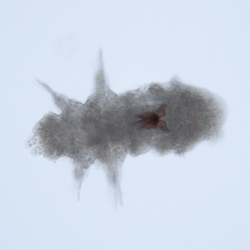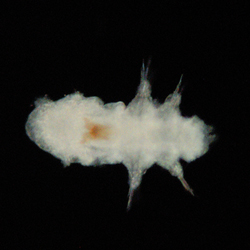

| Size under dissecting microscope: dependent on number of chaetae; this individual is 280µm |
| Morphology: We have attributed these larvae to Ophryotrocha, based on their general appearance, especially the jaw apparatus, which can be seen clearly through the body wall. |
| Frequency: Pump EPR 1999-2000: Common Pump EPR 2004: Common |
This group is most likely to be confused with Nereis sp. It can be quickly distinguished by its easily visible jaws and by the fact that Nereis larvae have four dark or reddish dots at the base of two adjacent pairs of parapodia. Nereis also has obvious antennae and tentacular cirri projecting from the sides of the head and is generally somewhat larger (300-450µm; individual at left is 400µm). |
|
 |
Unknown Polychaete A is similar in general outline to Ophryotrocha, but is smaller (this individual is 200µm), yellower in color and lacks the jaw apparatus. In this group, the chaetae are angled toward the posterior rather than sticking out to the sides. |
It is possible that Ophryotrocha might be mistaken for a small Glycera sp., as both species have visible jaws. However, the shape of the jaws is quite different and Glycera has four antennae in the form of a cross at the tip of its prostomium. We generally find it when it is much larger - ~ 600 - 700μm - and with more chaetigers. |
|
 |
Amphisamytha larvae are approximately the same size as Ophryotrocha, but lack jaws and obvious parapodia. |
Go to:
Home
Gastropods by Size
Gastropods by Species
Other Taxa